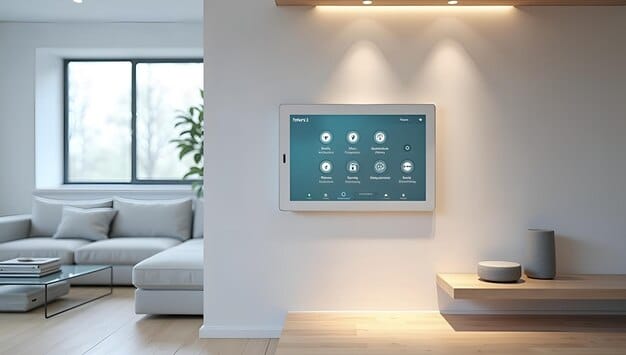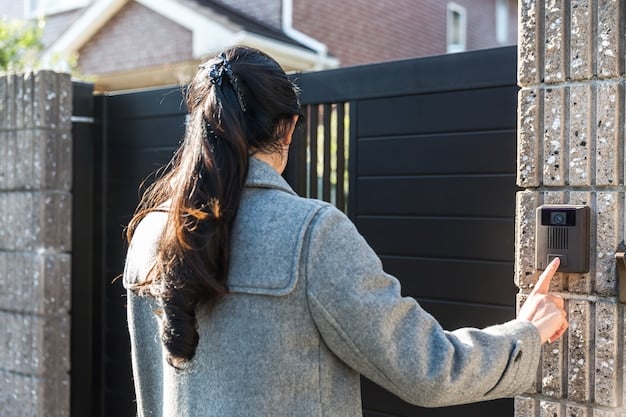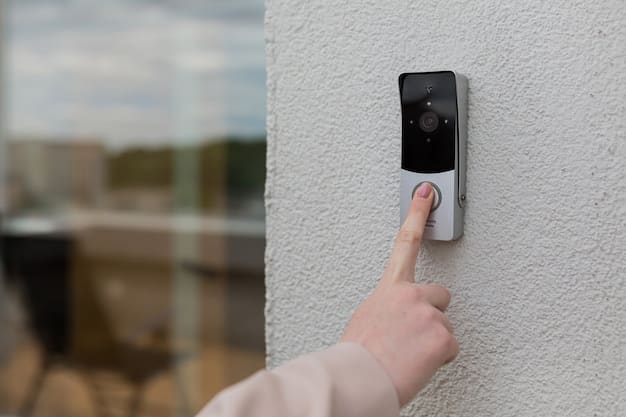DIY Home Security: Save $30/Month by Installing Your Own System

Considering a DIY home security system can significantly cut down costs, allowing homeowners to save an average of $30 per month on monitoring fees while ensuring their homes are protected using modern, self-installed technology.
Ready to take control of your home’s security and your budget? With the rise of affordable and easy-to-install technology, DIY home security is becoming an increasingly popular choice. You can save $30/month on monitoring fees with our tips.
Why Choose DIY Home Security?
DIY home security systems offer a compelling alternative to traditional monitored services. They hand you the reins, letting you choose your equipment, customize settings, and manage your security without long-term contracts or hefty monthly fees.
But beyond just saving money, DIY systems offer a level of customization and control that traditional options simply can’t match. Here’s a deeper look at why more and more homeowners are making the switch.
Cost Savings
The most immediate and obvious benefit is the cost savings. Traditional security systems often come with professional installation fees, equipment costs, and ongoing monthly monitoring charges. DIY systems eliminate most, if not all, of these expenses.
- No Installation Fees: Install the system yourself without professional installers.
- Reduced Monthly Fees: You avoid monthly monitoring costs by self-monitoring or opting for affordable cloud storage plans.
- Customizable Equipment: Tailor your system to fit your budget without being locked into expensive bundles.

Flexibility and Control
DIY systems offer unparalleled flexibility. You can choose the specific components that best meet your needs, from cameras and sensors to smart locks and alarms. You also have complete control over your system settings and data.
- Customization: Adapt the system to your specific home layout and security concerns.
- Data Privacy: Maintain control over your security footage and data storage.
- Scalability: Easily add or remove components as your needs change.
By opting for a DIY approach, you’re not just saving money; you’re also investing in a security solution that can adapt and evolve with your lifestyle. This ensures long-term peace of mind without the constraints of traditional contracts and fees.
Essential Components of a DIY Home Security System
Building a DIY home security system involves integrating several key components to create a comprehensive safety net. Understanding these components is crucial for designing a system that meets your specific needs.
Each element plays a critical role in protecting your home, from detecting intrusions to providing visual surveillance. Here’s an overview of the essential components you should consider.
Control Panel or Hub
The control panel is the brain of your security system, connecting all your devices and allowing you to manage them from a central location. It communicates with sensors, cameras, and other components, triggering alarms and notifications when necessary.
When selecting a control panel, consider its compatibility with different devices, ease of use, and ability to integrate with smart home platforms. A reliable control panel ensures seamless operation and effective management of your security system.
Entry Sensors
Entry sensors are designed to detect when doors and windows are opened, providing an immediate alert to potential intrusions. These sensors consist of two parts: one attached to the door or window and the other to the frame.
- Door Sensors: Placed on all exterior doors to detect unauthorized entry.
- Window Sensors: Installed on windows, especially those on the ground floor, to prevent break-ins.
Choose wireless sensors for easy installation and placement flexibility. These sensors provide essential perimeter protection, ensuring you’re immediately notified of any unauthorized access attempts.

Security Cameras
Security cameras are a vital part of any home security system, providing visual surveillance both inside and outside your home. They can deter potential intruders and provide valuable evidence in the event of a break-in.
- Indoor Cameras: Monitor interior spaces, ensuring the safety of your family and belongings.
- Outdoor Cameras: Protect your property’s perimeter, capturing footage of potential threats.
Consider features like night vision, motion detection, and remote viewing capabilities when selecting security cameras. High-quality cameras provide clear and reliable footage, enhancing your overall security.
By thoughtfully integrating these essential components, you can create a robust and effective DIY home security system that provides comprehensive protection for your home and family.
Step-by-Step Guide to Installing Your DIY Security System
Installing a DIY home security system might seem daunting, but with the right preparation and a methodical approach, it can be a straightforward process.
Here’s a step-by-step guide to help you set up your system efficiently and effectively.
Step 1: Plan Your System
Before you start buying equipment or drilling holes, take the time to plan your security system. Assess your home’s vulnerabilities and identify the areas that need the most protection.
- Assess Vulnerabilities: Identify potential entry points and areas of concern.
- Determine Equipment Needs: List the specific components you’ll need based on your assessment.
Step 2: Purchase Your Equipment
Once you have a clear plan, purchase the necessary equipment. Look for reputable brands and read reviews to ensure you’re getting reliable and effective components.
- Control Panel or Hub: The central control unit for your system.
- Entry Sensors: For doors and windows.
- Security Cameras: Indoor and outdoor as needed.
Step 3: Install the Control Panel
Start by installing the control panel in a central location in your home. Follow the manufacturer’s instructions to connect it to your Wi-Fi network and power source.
A well-placed and properly connected control panel is essential for the seamless operation of your entire security system.
Step 4: Install Entry Sensors
Next, install entry sensors on all exterior doors and windows. Clean the surfaces where you’ll be attaching the sensors, and follow the manufacturer’s instructions for placement.
Ensure the sensors are properly aligned and securely attached to prevent false alarms and ensure reliable detection.
Step 5: Set Up Security Cameras
Place your security cameras in strategic locations, both inside and outside your home. Follow the manufacturer’s instructions to mount the cameras and connect them to your Wi-Fi network.
Adjust the camera angles and settings to capture clear footage and cover the areas you want to monitor.
Step 6: Test Your System
After installing all the components, thoroughly test your system. Open and close doors and windows to ensure the entry sensors are working correctly.
Check the camera feeds to ensure they’re providing clear and reliable video. Test the alarm system to verify that it’s functioning properly.
By following these steps, you can successfully install your DIY home security system and enjoy the peace of mind that comes with knowing your home is protected.
How to Save $30 a Month on Monitoring Fees
One of the biggest advantages of a DIY home security system is the potential to save money on monthly monitoring fees. Traditional security companies often charge a premium for 24/7 monitoring services, but with a DIY system, you can significantly reduce or eliminate these costs.
Here’s how you can save $30 a month and more by taking a do-it-yourself approach.
Self-Monitoring
The most straightforward way to save on monitoring fees is to self-monitor your system. This means you’ll receive alerts and notifications directly to your smartphone or tablet and be responsible for responding to any security events.
- Real-Time Alerts: Receive instant notifications when sensors are triggered or alarms are activated.
- Direct Control: Manage your system remotely using a mobile app.
Self-monitoring gives you complete control over your home security, allowing you to respond to incidents quickly and efficiently.
Affordable Cloud Storage
Instead of paying for professional monitoring, consider using cloud storage for your security camera footage. Many DIY security systems offer affordable cloud storage plans that allow you to record and store video footage for a small monthly fee.
- Cost-Effective: Cloud storage is typically much cheaper than professional monitoring services.
- Remote Access: Access your security footage from anywhere with an internet connection.
Cloud storage ensures that you have a record of any security events, providing valuable evidence in the event of a break-in or other incident.
No Long-Term Contracts
Traditional security companies often require long-term contracts that can be difficult and expensive to break. With a DIY system, you have the freedom to cancel or modify your service at any time without penalty.
- Flexibility: Adjust your system as your needs change.
- No Cancellation Fees: Avoid costly penalties for ending your service early.
The flexibility of a DIY system allows you to adapt your security setup to fit your budget and lifestyle, maximizing your savings.
By opting for self-monitoring, affordable cloud storage, and avoiding long-term contracts, you can easily save $30 a month or more on monitoring fees, making a DIY home security system a smart financial choice.
Smart Home Integration for Enhanced Security
Integrating your DIY home security system with smart home devices can significantly enhance its effectiveness and convenience. Smart home integration allows you to automate security tasks, control devices remotely, and create a more seamless and responsive security environment.
Here are several ways to integrate your DIY system with smart home technology.
Smart Locks
Smart locks replace traditional door locks with electronic versions that can be controlled remotely using a smartphone app or keypad. They offer enhanced security features such as keyless entry, temporary access codes, and real-time monitoring.
- Remote Access: Lock and unlock your doors from anywhere.
- Temporary Codes: Provide temporary access to guests or service providers.
Smart locks add an extra layer of security to your home, making it more difficult for intruders to gain access.
Smart Lighting
Smart lighting systems allow you to control your home’s lights remotely, creating the illusion that someone is home even when you’re away. This can deter potential intruders and enhance your home’s security.
- Remote Control: Turn lights on and off from your smartphone or tablet.
- Automated Schedules: Set lights to turn on and off automatically at specific times.
Smart lighting is an easy and effective way to deter break-ins and improve your home’s overall security.
Voice Assistants
Integrating your security system with voice assistants like Amazon Alexa or Google Assistant allows you to control your system using voice commands. You can arm or disarm your system, check the status of your sensors, and view camera feeds using simple voice commands.
- Hands-Free Control: Manage your security system without lifting a finger.
- Seamless Integration: Connect your security system to other smart home devices.
Voice assistants make it easier and more convenient to manage your home security system, enhancing its overall effectiveness.
By integrating your DIY home security system with smart home devices, you can create a more secure, convenient, and responsive security environment for your home and family.
| Key Feature | Brief Description |
|---|---|
| 💰 Cost Savings | Reduce monthly fees by self-monitoring or using affordable cloud storage. |
| 🛠️ DIY Installation | Install the system yourself without professional fees. |
| 🔒 Enhanced Security | Integrate smart locks and lighting for better home protection. |
| 📲 Real-Time Alerts | Get instant notifications on your smartphone for immediate response. |
Frequently Asked Questions
▼
Savings vary, but many homeowners save around $30 a month by avoiding professional monitoring fees. Self-monitoring and affordable cloud storage are key to these savings.
▼
Yes, DIY systems can be very effective, especially when integrated with smart home technology. The key is to plan your system carefully and use reliable equipment.
▼
Essential components include a control panel, entry sensors for doors and windows, and security cameras for both indoor and outdoor surveillance.
▼
Absolutely! Integrating your system with smart locks, lighting, and voice assistants enhances its convenience and effectiveness, providing a more comprehensive security solution.
▼
No, most DIY systems are designed for easy installation. Following the manufacturer’s instructions and taking a methodical approach will help you set up your system efficiently.
Conclusion
Switching to a DIY home security system can save you a significant amount each month while providing robust protection for your home. With careful planning, the right equipment, and a bit of effort, you can enjoy peace of mind without the hefty price tag of traditional security services.





